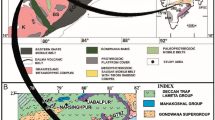Summary
Two main geochemiscl types of granites are distingushed in the Salmi pluton: 1) ovoid biotite-hornblende granites, 2) non-ovoid biotite granites. The first one is characterized by higher CO2, CO and CH4 concentrations. The second type is rich in fluorine and shows similarities with rare metal Phanerozoic granites. Both granite types began to crystallize when Pf, < Ptot, but non-ovoid granites, which crystallized in a wider temperature range, reached conditions Pf, > POtot at the final stage. The mole fraction of carbon group gases (CO2, CO and CH4) decreases and that of H2O increases in all granites from early crystallizing minerals to those of late crystallization.
Compositional differences between ovoid biotite-hornblende and non-ovoid biotite granites are due to differences in the protolith composition.
Zusammenfassung
Zwei geochemisch charakterisierte Granittypen können innerhalb des Salmi Plutons unterschieden werden: 1) ein ovoidaler Biotit-Hornblende-Granit, und 2) ein nichtovoidaler Biotit-Granit. Der erste Typ ist durch höhere Konzentrationen von CO2, CO und CH4 charakterisiert; der zweite Granittyp ist reich an Fluor und zeigt Ähnlichkeiten mit phanerozoischen Graniten, die seltene Metalle führen. Beide Granittypen beginnen bei Pfl, < Ptot, zu kristallisieren, nicht-ovoidale Granite jedoch, deren Kristallisation in einem weiteren Temperaturbereich abläuft, erreichen im Finalstadium der Kristallisation Pfl > Ptot,-Bedingungen. In allen Graniten sinkt die Molfraktion der Kohlenstoffgasgruppe (CO2, CO und CH4) bei gleichzeitigem Anstieg von H2O, wenn man frühe Kristallisationsphasen mit späten vergleicht.
Die Unterschiede in der Zusammensetzung zwischen den ovoidalen und nichtovoidalen Graniten sind auf Unterschiede in der Protolith-Zusammensetzung zurückzuführen.
Similar content being viewed by others
References
Belyaev AM, Rundqvist ND, Shapkina IS (1990) Sostav i stroyenie ovoidov kalievogo polevogo shpata granitov rapakivi Vyborgskogo massiva. Vestnik LGU Ser 7, Vyp 2 S: 17–25 (in Russian)
Conrad WK, Nicholls IA, Wall VJS (1988) Water-saturated and undersaturated melting of metaluminous and peraluminous crustal compositions at 10 kb: evidence for the origin of silicic magmas in the Taupo volcanic-zone, New Zealand, and other occurrences. J Petrol 29: 765–801
Haapala I (1977) Petrography and geochemistry of the Eurajoki stock, a rapakivi-granite complex with greisen-type mineralization in southwestern Finland. Geol Surv Finland Bull 286: 128
Kornfdlt KA (1976) Petrology of the Ragunda rapakivi massif, Central Sweden. SGU Ser C 72: 4–111
Kovalenko VI (1977) Petrologia i geokhimia redkometalnykh granitoidov. Nauka, Novosibirsk, p 204 (in Russian)
Letnikov FA, Gantimirova TP (1988) Fluidno-petrokhimicheskaya tipizatsia granitoidov. Petrologia i fluidnyi rezhimkontinentalnoi litosfery. Nauka, Novosibirsk, pp 78–85 (in Russian)
Letnikov FA, Karpov IK, Kiselyov AI (1977) Fluidnyi rezhim zemnoi kory i verkhnei mantii. Nauka, Moskva, p 213 (in Russian)
Litvinovsky BA (1989) O glubine zarozhdenia kislykh magm na etapakh aktivizatsii odvizhnykh poyasov. Geologia i geofisika 6 S: 45–53 (in Russian)
Marakushev AA (1977) Nekotorye geokhimicheskiye aspekty fluidnogo rezhima. Fluidny rezhim zemnoi kory i verkhnei mantii, Irkutsk, pp 9–10
Neymark L, Amelin YU, Larin A (1991) Geochronology of the rocks of the Salmi batolith. In:Haapala I, Rämö OT, Salonsaari PT (eds) Excursion Salmi batholith and Pitkäranta ore field in Soviet Karelia. Espoo 1991, p 34
Rub MG, Khetchikov LN, Rub AK, Kotelnikova ZA (1986) Vkliucheniya mineraloobrazuyuscchikh sred v mineralakh dokembriiskikh olovonosnykh granitov severnogo Priladozhya. Izv AN SSSR Ser Geol I: 30–36 (in Russian)
Svetov AP, Sviridenko LP, Ivashchenko YI (1990) Vulcano-plutonism svecokarelid Baltiiskogo shchita.. Karelia, Petrozavodsk, p 320 (in Russian)
Sviridenko LP (1968) Petrologia Salminskogo massiva granitov rapakivi (v Karelii). Trudy Inst geol Karelskogo filiala AN SSSR Vyp 3: 115 (in Russian)
Sviridenko LP (1990) Granitization as a major crust-for-ming process in Karelia, USSR. Geol Zb-Geol Carpatica 41: 739–748
Vorma A (1976) On the petrochemistry of rapakivi granites with special reference to the Laitila massif southwestern Finland. Geol Surv Finland Bull 285: 198
Author information
Authors and Affiliations
Additional information
With 2 figures
Rights and permissions
About this article
Cite this article
Sviridenko, L.P. The evolution of the fluid phase during the crystallization of granite types: Salmi pluton, Karelia, Russia. Mineralogy and Petrology 50, 59–67 (1994). https://doi.org/10.1007/BF01160139
Received:
Accepted:
Issue Date:
DOI: https://doi.org/10.1007/BF01160139




